News Updates
Please find here some of our latest news items, including SRDC press releases:
The first ever Rupununi Indigenous Women's Conference was held in Annai Village, North Rupununi from January 6 - 9, 2020 under the theme; '' Empowering and Strengthening Indigenous Women: Working together for a green future.''This event was supported by WWF- Guianas through the Shared Resources Joint Solutions (SRJS) programme. This conference was jointly hosted by the South Rupununi District Council and the North Rupununi District Development Board with the aim to create a space for indigenous women from all areas of the Rupununi to come together to discuss and focus on gender, leadership, environment issues and empowerment.
For the three days of the conference, women participated in group work, public speaking and were albe to engage and excahnge with eachother on their work and experiences in their various communities. A cultural evening was also held where women told stories, recited poems, sang songs and shared their experiences as leaders in the community. The last day of the confrerence ended with a visit to the Wowetta Women's Farine Factory.
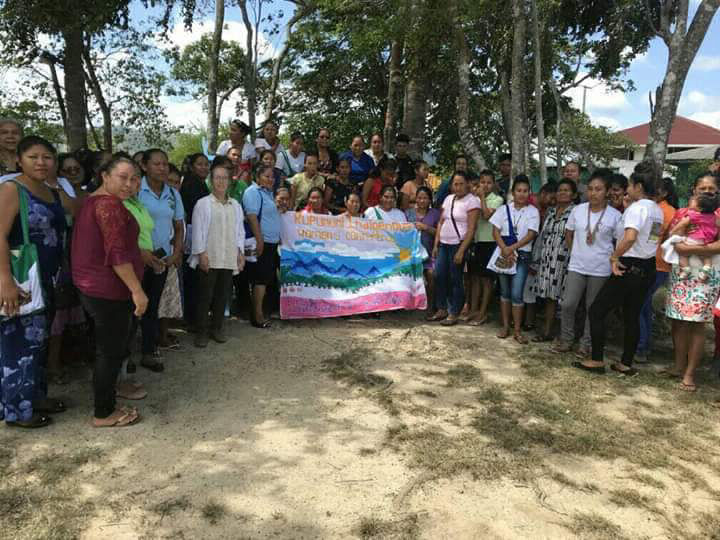
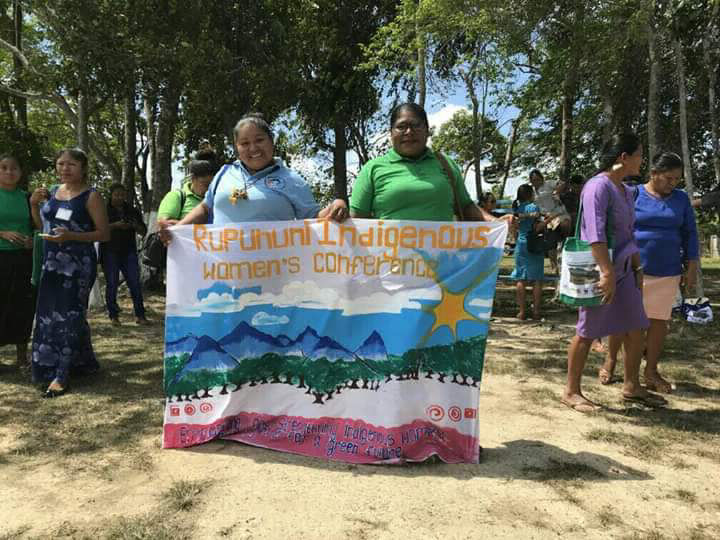
The SRDC Youth Conference was held in Karuadarnau Village from December 16- 19 , 2019 under the theme: 'Preserving, safeguarding and maintaining our pristine environment: through traditional practices and youth empowerment. This years youth conference brought together 189 youths from the variousvillages within the Wapichan Wiizi. Youths were placed into three groups, and for the four days were involved in many activities, such as feild trips, group work, scavenger hunts, games and cultural shows. This allowed youths to come together, share ideas and to plan on how they can protect their environment.
The SRDC held it's last quarterly meeting for the year in Sawariwau Village from November 6-8, 2019. Over 200 persons attended the first day of the meeting. Discussions were held with Minister of Natural Respources Hon. Raphael Trotman on the protection of the main water sheds in the South Rupununi. Minister updated all on the existing order of 2009 that prohibits all river mining in the South Rupununi.
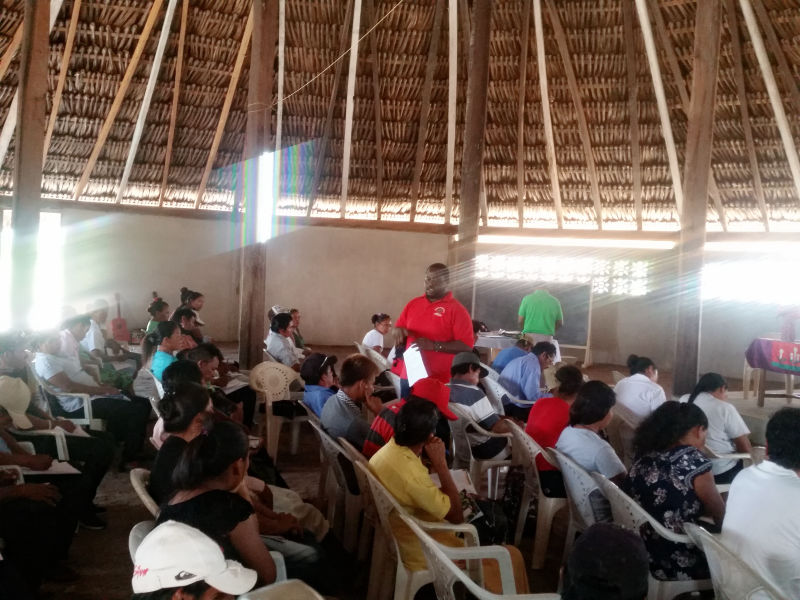
SRDC outreach visit to Parabara Village
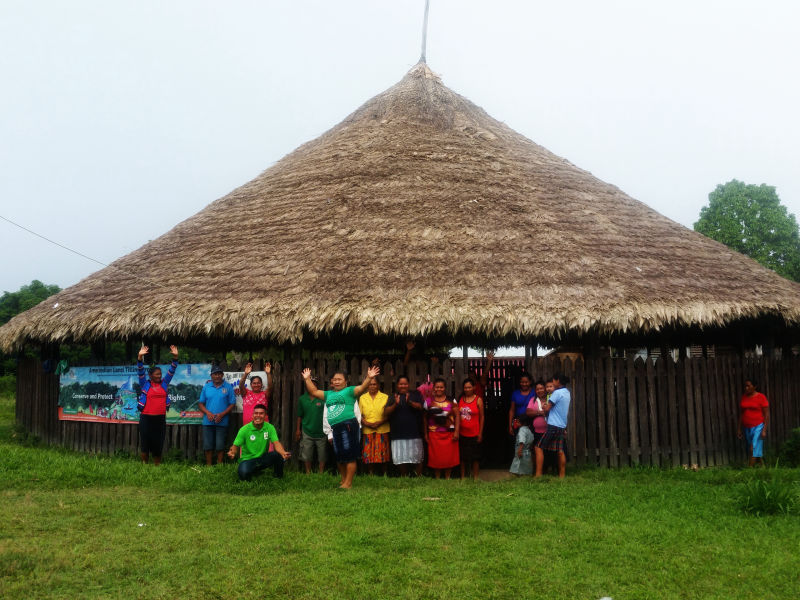
Staff of the SRDC Sub - Office in Aishalton Village supporting the Climate Change Strike.
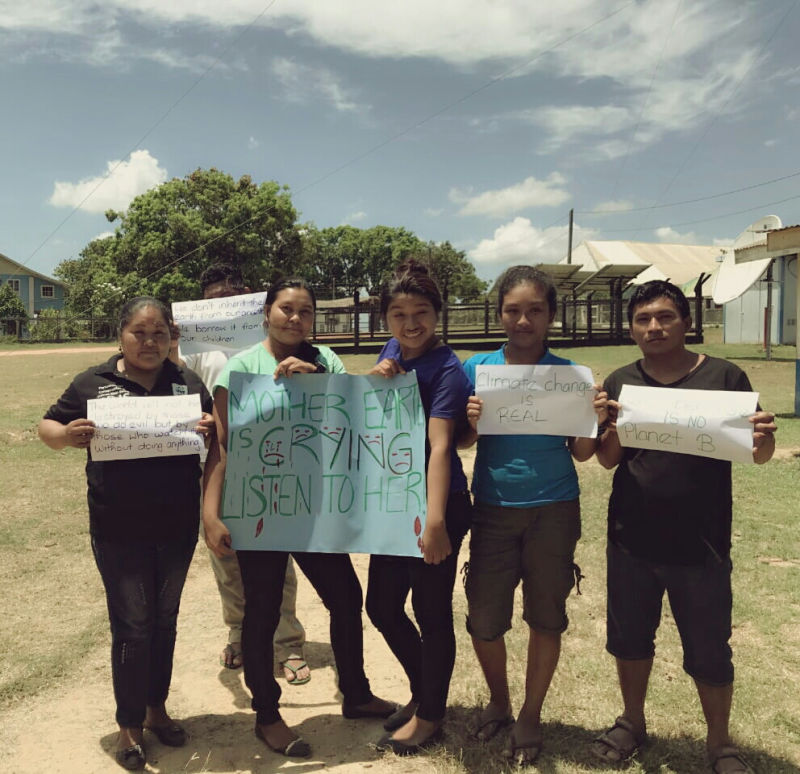
SRDC Alarmed by Fuel Spill in Creek
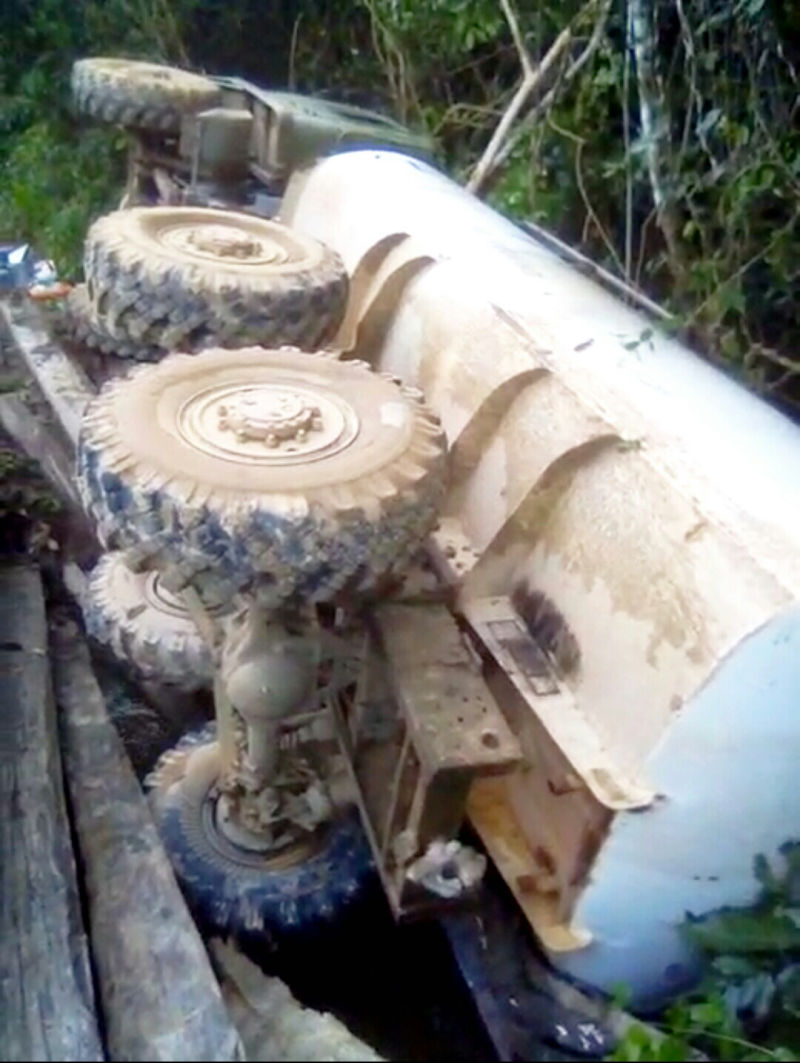
The South Rupununi District Council (“SRDC”), the representative institution of the 21 communities in the South Rupununi, expresses its grave concern over the pollution of Ikizapa Wao (“creek”), which falls within Aishalton Village’s titled lands, by a large diesel spill. Last Wednesday, October 10, 2019, the SRDC received reports that a truck owned by V. Dalip Enterprise and carrying over 100 drums of fuel broke the Ikaazupu Wao bridge, causing the truck to then topple over and spill approximately 30 drums of diesel into the creek.
This creek flows into Tooto Wao, which in turn flows in to Kwitaro River. Our people not only in Aishalton Village but also in the villages of Awarewaunau, Maruranau and Shea depend upon this river ecosystem. This fuel spill and pollution of such critical waterways will harm our fishes, wildlife, and livelihoods. Our people fish and hunt in these rivers and creeks.
This fuel spill provides just one example of the concerns raised last week at the just concluded National Toshaos Conference. Kid James, project coordinator for the SRDC, had expressed concerns about the damage that mining trucks and excavators have caused to transport infrastructure in the South Rupununi. He recommended that the Government of Guyana review and improve its policies and laws on mining, including on the way mining concessions are issued and on the environmental, social, human rights, economic, and infrastructural impacts of mining. Importantly, the Government of Guyana must also improve the enforcement of laws and regulations. The review and improvement of these laws, policies, and enforcement measures must be done in conjunction with indigenous peoples, who are the ones most impacted by mining activities. Mr. James’ statements were echoed by representatives and Toshaos of other communities and regions in Guyana, and the final resolution of the NTC Conference reflected these concerns and included associated recommendations.
This latest environmental catastrophe only serves to reinforce the need for the effective development and implementation of the headwaters protection plan already agreed upon between the Ministry of Natural Resources and the SRDC. The plan for the protection of the headwaters of the Kwitaro and Kuyuwini Rivers is currently under discussion between the Ministry and the SRDC and would ban mining in and near those rivers and aim to preserve the health of those waterways. We look forward to working with the Ministry to jointly develop and implement this important measure for the protection of our waterways, our environment, and our land, and we hope it will serve as a useful model for other communities in Guyana as they struggle with their own mining-related issues.
Urgent action needed to prevent Dragga from Operating Illegally in the Kuyuwini and Upper Essequibo Rivers
Despite numerous commitments by the Government since December 2018, to date, no concrete steps have been taken to resolve the issue of the dragga in Parabara Village in the South Rupununi.
In December of 2018, the South Rupununi District Council (SRDC) informed the Guyana Geology and Mines Commission of its concern over the dragga being constructed in the Village of Parabara. At the time, the SRDC demanded that the dragga be dismantled, but the GGMC cited a lack of authority to act unless the dragga began to operate. Since then, the dragga has been built and begun to move down the river, and we are deeply concerned that it will imminently begin river mining operations in our territory, given the amount of fuel that has just been carried down for it.
The SRDC appreciates the efforts the Government has taken thus far to ensure that the dragga will not operate and cause destruction to our environment. In May 2019, Cabinet took a decision to refuse permission for the dragga to operate. Major General Joseph Singh informed us that H.E. President Granger has declared that this Government shall enforce the order issued in 2008 and not allow any mining in the tributaries of and the Essequibo River south of the 4th Parallel. In June 2019, the GGMC issued an Order to Remove the dragga by June 14, 2019 (see image of the order below). The Minister of Natural Resources has additionally committed to the protection of important headwaters in the South Rupununi.
It is thus with the gravest concern that we report that in spite of these orders and decisions, the dragga has yet to be removed. A 14-inch cutterhead dredge could only be built with one purpose – to engage in river mining which contravenes a government order and Cabinet decision. The SRDC urges the GGMC and MNR to take immediate action, including forfeiture and seizure, which is authorized under the Mining Act, Sections 100-103. Immediate enforcement action must be taken to enforce the decisions and orders of the government as well as to ensure the government’s commitment to the protection of important headwaters in the South Rupununi.
Just a week ago, officers from GGMC informed the SRDC that fuel was taken in to where the dragga was located, so as to have it return to the landing at Parabara where it was constructed.
On September 8, 2019 the SRDC received information that the dragga moved further down along the river with a pontoon carrying almost 400 drums of fuel for the operations of the dragga. After receiving this information, the SRDC sent in its monitoring team to verify that indeed the dragga was returning. However, the SRDC has received confirmed reports from its monitoring team that the dragga has indeed moved further down river.
On the 6th September 2019 the Government of Guyana signed the “Leticia Pact For The Amazon Region committing to, among others, “to establish regional cooperation mechanisms …to combat illegal activities threatening the conservation of the Amazon Region”; “strengthen the mechanisms that support and promote sustainable use of forests”; and “strengthening capacities and participation of Indigenous peoples..in the sustainable development of the Amazon Region, acknowledging their fundamental role in the conservation of the region”.
The South Rupununi communities have committed to contribute to the protection of our sacred Amazonian forests, a part of which forms Wapichan traditional lands. These very lands are the source of fresh water that feeds into our mighty Essequibo and supports extremely fragile ecosystems. In a time when other parts of the Amazon are being destroyed on a scale of apocalyptic proportions, Guyana has a chance to step up and lead the way on helping the world heal its ecological scars. The SRDC commits to continuing to work with the GGMC, MNR, and the EPA in protecting our environment and dealing with issues that are in breach of mining and environmental laws and regulations.
The reports of our monitoring team indicate that the dragga operator is openly defying the order of a GGMC officer, a 2008 governmental order, and a decision of Cabinet. The SRDC therefore urgently demands that the GGMC and other relevant government agencies take immediate and appropriate actions to address this extremely alarming situation and to enforce its own laws, orders, and commitments.
UN Echoes SRDC’s Concern over Discrimination Faced by Indigenous Women in Guyana
The South Rupununi District Council (SRDC) welcomes the Concluding Observations on Guyana by the UN Committee on the Elimination of All Forms of Discrimination Against Women released on 22 July 2019. The Committee’s Concluding Observations are timely and incorporate many of the SRDC’s recommendations for government action to address discrimination against indigenous women. The SRDC’s recommendations were made in a shadow report submitted to the Committee and presented by SRDC representative Immaculata Casimero during the Committee’s 73rd session in Geneva.
The SRDC recognizes the government’s implementation of programmes for women’s development as an important step; however, as our representative Ms. Casimero noted to the CEDAW Committee, the government’s efforts often do not reach our communities. We are pleased that the CEDAW Committee shares our concerns and we hereby urge the government to adopt the recommendations of the CEDAW Committee and collaborate with the SRDC and other indigenous organisations in order to bridge the gap between the hinterland and the coastal areas.
Immaculata Casimero, an SRDC representative and women’s rights activist, travelled to Geneva, where the mentoring programme From Global to Local, organised by the International Women’s Rights Action Watch, worked with her to prepare a presentation to the CEDAW Committee. Ms. Casimero both provided important inputs into the CEDAW review process and also gained significant experience, relating:
[T]he programme fully prepared me to give an oral statement before CEDAW. I learned about how the human rights system operate, where CEDAW fits, and how CEDAW can be used to advocate for women’s rights. Being able to work with women from other countries has been a life-changing experience where I felt motivated and encouraged to do more for the women in my territory. Listening to the experiences and challenges shared by women from other countries, I built my courage and self-confidence, knowing they are all working on a common goal in advocating for women’s equality and equity which I can then voice for vulnerable women.
Ms. Casimero’s oral presentation and private discussion with the CEDAW committee members helped shape the Concluding Observations finally issued by the Committee. Ms. Casimero briefed the committee members on the many issues affecting indigenous women and girls in our territory and also on issues affecting women nationally. The Committee incorporated the SRDC’s concerns and recommendations, as raised by Ms. Casimero, in the constructive dialogue between them and Guyana and later into the Concluding Observations.
Notably, the CEDAW Committee called on the government of Guyana to amend its laws to guarantee the rights of indigenous women and girls, including to guarantee our rights to our traditional lands and territories; to guarantee our right as indigenous women to consultation and free, prior, and informed consent to policies and legislation affecting us; to improve the access to services for indigenous women, particularly for victims of gender-based violence and sexual offences; to increase livelihood and job opportunities for indigenous women; and to accelerate educational and awareness raising efforts to eliminate discriminatory stereotypes against women and particularly indigenous women. We quote a few of these recommendations here:
Expedite the approval of amendments to the Sexual Offences Act and create dedicated sections and/or time slots for the treatment of the sexual offences in courts in the hinterland, including in mobile courts…;
Expedite the implementation of the essential services package for victims of gender-based violence, establish shelters and crisis centres for victims of gender based violence in all regions of the State party, allocate sufficient resources to ensure their effective functioning and enhance the provision of accommodation, rehabilitation and reintegration measures for victims, especially in the hinterland;
Carry out nationwide education awareness-raising campaigns, including in indigenous languages and on the local radio, about the risks and criminal nature of trafficking as well as the available support services…
[A]ccelerate women’s, especially indigenous women’s, full and equal participation in political and public life…;
Take targeted measures … to improve access for women, and especially indigenous women and women with disabilities to the formal employment sector;
Guarantee the consultation of rural and Amerindian women and girls in the development and implementation of policy and legislative measures, including through organizations representing them, district and village councils…;
Amend the Amerindian Act (2006) and other relevant laws, using a gender-sensitive approach, with a view to ensuring that the rights of Amerindian communities to their lands, territories and resources are fully recognized and protected, in accordance with the United Nations Declaration on the Rights of Indigenous Peoples;
[G]uarantee that rural and Amerindian women (i) can fully contribute to the development of the country through its Green State Development Strategy, (ii) have given their free, prior and informed consent before initiating any development, business, agro-industrial or extractive projects affecting their traditional lands and resources … (iii) can take advantage of adequate benefit-sharing agreements, and (iv) are provided with alternative livelihoods….
The SRDC additionally emphasize; highlights the need for the Government to improve access to justice in indigenous communities; to use verified data collection to determine the effects of mining on indigenous women and to combat the negative impacts of mining; to implement programs, in conjunction with indigenous communities and indigenous women, to assist with adapting to climate change and fighting the resulting food insecurity; to increase capacity-building efforts not only on CEDAW and women’s rights but also on sexual and reproductive health and on the negative impacts of gender stereotyping; and to address the issue of rising numbers of teenage pregnancies. We refer the Government of Guyana to our shadow report for more detailed concerns and recommendations on how to address them to ensure that indigenous women in Guyana can actually enjoy their rights protected under CEDAW in their day to day lives.
The SRDC urges the Government of Guyana to respect its treaty obligations, to implement the recommendations made by CEDAW, and to work collectively with the SRDC, other indigenous representative institutions, and indigenous NGOs to ensure that indigenous women can fully enjoy the rights recognized under CEDAW.
South Rupununi council alarmed at ‘illegal’ river dredges in Kuyuwini River
By David Papannah
One of the dredges that is said to be operating on the Kuyuwini River.
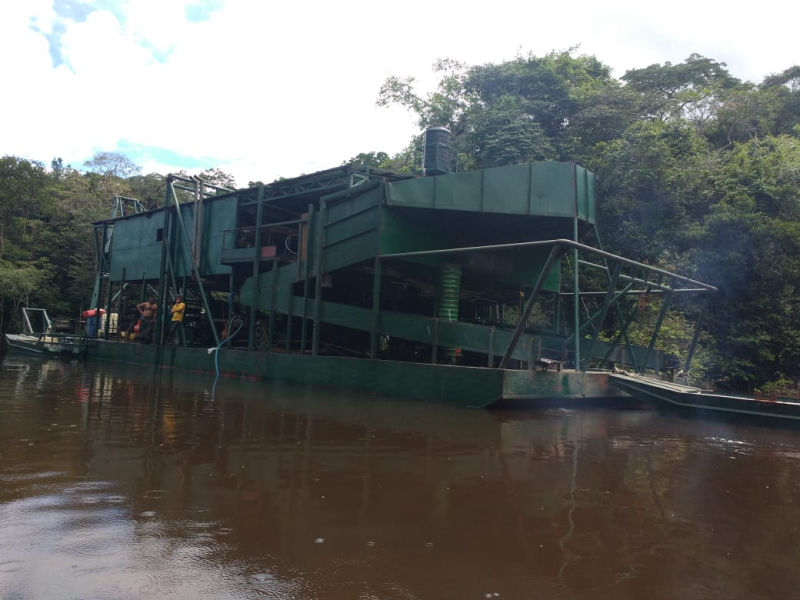
At least two river dredges are operating illegally in the Kuyuwini River in Region Nine in areas that were declared no mining zones, according to the South Rupununi District Council (SRDC), which has expressed alarm at the destruction being caused to the largely pristine area by the gold mining operations.
Commissioner of the Guyana Geology and Mines Commission (GGMC) Newell Dennison told the Sunday Stabroek when contacted that the agency is aware of the dredges in the river and had issued “citations” previously. He said that the issue is a reoccurring one and is still being addressed by the GGMC.
SRDC Chairman Nicholas Fredericks told the Sunday Stabroek that the grouping, made up of indigenous leaders and representatives from across the South Rupununi, is calling on the GGMC to swiftly address the situation. He said that based on information gathered, two “draggas” are currently engaged in mining operations up the river beyond the fourth parallel of the latitude mark. There is reportedly a directive that forbids riving mining south of the fourth parallel.
According to Fredericks, some months ago, GGMC officers served cease work orders to one of the mining operations in the Kuyuwini River but to their understanding, the dredge remains in the waterway and they believe that mining operations are continuing. He explained that they have noticed fuel trucks travelling through the villages transporting fuel to at least one of the operations.
GGMC officers on June 14th, he said, served cease work orders on the dredge owner, who is a well-known miner.
“When they went to [the] dragga to issue the removal order, one of our monitors accompanied the GGMC officers and there was evidence of them operating. The dragga is working and mats were filled with mud indicating they were working,” Fredericks said.
After the order was served, the businessman, who reportedly renewed his mining claims earlier this year, indicated that he would have to source approximately 40 drums of gasoline to move his operations from the area where it was operating at the time.
“Right now we are in contact with GGMC to see what is going on there… we have heard that they are still continuing to operate,” the SRDC chairman said. He noted that with the operation continuing, gold is being extracted.
He said that from the time they noticed the construction of the dredge in the river last December, they registered their concern with the GGMC and Minister of Natural Resources Raphael Trotman. In the communications received from Trotman and GGMC, Fredericks said, it was indicated that the authorities cannot intervene and stop the construction of the dredge since there is no law that allows for such action.
“The construction of the dragga began in December and we started to ask questions and we checked on whose operations it is… We found they have the permits, so [we] wrote to GGMC and Minister Trotman for them to intervene and [they] said they cannot do anything about the construction of the dragga because there is no law to stop the construction of the equipment,” Fredericks recounted.
He further related that when they observed the dredge moving up the river, contact was established with Trotman and the GGMC and “it was indicated no permission will be granted for mining operations beyond the fourth parallel.”
In addition, Fredericks said that they have also received reports of another dredge working further down the Kuyuwini River, approximately 125 miles from Parabara.
“…There is another operation that is further down, 125 miles [down the] Kuyuwini River from Parabara. Fuel is being transported to the area and if they can carry fuel…they are landing somewhere on one of those South communities and take the fuel to the operations,” Fredericks added.
Dennison told the Sunday Stabroek that the presence of dredges operating in the river is on the GGMC’s radar.
He said that within the last few months, visits were made to the area and citations were issued to operators. He added that they have indicated to the SRDC that permits will not be granted to miners to work in areas where mining is not permitted. He reiterated that the matter is still being addressed by the GGMC and they have been responding to concerns raised by the SRDC.
Dennison, however, said that they cannot to impose sanctions on operators who are not found in breach of the laws. He emphasised that persons found to be in breach of the laws will have the necessary actions taken against them and their operations.
The GGMC head related that they have consulted with the operator when he visited the GGMC’s offices and areas that were off limits to mining were communicated to him.
Meanwhile, Fredericks said from his observation, at least 17 miles of palm trees were wiped out from the river since the dredge has been operating there. This, he said, indicates a negative environmental impact since it is not trees alone that are destroyed but habitats for wildlife.
SRDC executive member Kid James questioned why the GGMC is allowing mining operations in areas where the regulatory agency is unable to work. His remarks were made in reference to the newly discovered mining operations down the river from Parabara.
“Mr Dennison claimed recently that miners are not abiding by the mining regulations and this is what we keep telling GGMC and asking what is happening here. Why would you sell claims to areas that you cannot access or have your people go into and monitor and do your work? Why?” James said.
“The track records of dragga and what they have done doesn’t mesh with the plan of the country’s green state development plan. That is why we would like to see they stop river mining in accordance with the order,” James stressed.
UN Echoes SRDC’s Concern over Discrimination Faced by Indigenous Women in Guyana
The South Rupununi District Council (SRDC) welcomes the Concluding Observations on Guyana by the UN Committee on the Elimination of All Forms of Discrimination Against Women released on 22 July 2019. The Committee’s Concluding Observations are timely and incorporate many of the SRDC’s recommendations for government action to address discrimination against indigenous women. The SRDC’s recommendations were made in a shadow report submitted to the Committee and presented by SRDC representative Immaculata Casimero during the Committee’s 73rd session in Geneva.
The SRDC recognizes the government’s implementation of programmes for women’s development as an important step; however, as our representative Ms. Casimero noted to the CEDAW Committee, the government’s efforts often do not reach our communities. We are pleased that the CEDAW Committee shares our concerns and we hereby urge the government to adopt the recommendations of the CEDAW Committee and collaborate with the SRDC and other indigenous organisations in order to bridge the gap between the hinterland and the coastal areas.
Immaculata Casimero, an SRDC representative and women’s rights activist, travelled to Geneva, where the mentoring programme From Global to Local, organised by the International Women’s Rights Action Watch, worked with her to prepare a presentation to the CEDAW Committee. Ms. Casimero both provided important inputs into the CEDAW review process and also gained significant experience, relating:
[T]he programme fully prepared me to give an oral statement before CEDAW. I learned about how the human rights system operate, where CEDAW fits, and how CEDAW can be used to advocate for women’s rights. Being able to work with women from other countries has been a life-changing experience where I felt motivated and encouraged to do more for the women in my territory. Listening to the experiences and challenges shared by women from other countries, I built my courage and self-confidence, knowing they are all working on a common goal in advocating for women’s equality and equity which I can then voice for vulnerable women.
Ms. Casimero’s oral presentation and private discussion with the CEDAW committee members helped shape the Concluding Observations finally issued by the Committee. Ms. Casimero briefed the committee members on the many issues affecting indigenous women and girls in our territory and also on issues affecting women nationally. The Committee incorporated the SRDC’s concerns and recommendations, as raised by Ms. Casimero, in the constructive dialogue between them and Guyana and later into the Concluding Observations.
Notably, the CEDAW Committee called on the government of Guyana to amend its laws to guarantee the rights of indigenous women and girls, including to guarantee our rights to our traditional lands and territories; to guarantee our right as indigenous women to consultation and free, prior, and informed consent to policies and legislation affecting us; to improve the access to services for indigenous women, particularly for victims of gender-based violence and sexual offences; to increase livelihood and job opportunities for indigenous women; and to accelerate educational and awareness raising efforts to eliminate discriminatory stereotypes against women and particularly indigenous women. We quote a few of these recommendations here:
Expedite the approval of amendments to the Sexual Offences Act and create dedicated sections and/or time slots for the treatment of the sexual offences in courts in the hinterland, including in mobile courts…;
Expedite the implementation of the essential services package for victims of gender-based violence, establish shelters and crisis centres for victims of gender based violence in all regions of the State party, allocate sufficient resources to ensure their effective functioning and enhance the provision of accommodation, rehabilitation and reintegration measures for victims, especially in the hinterland;
Carry out nationwide education awareness-raising campaigns, including in indigenous languages and on the local radio, about the risks and criminal nature of trafficking as well as the available support services…
[A]ccelerate women’s, especially indigenous women’s, full and equal participation in political and public life…;
Take targeted measures … to improve access for women, and especially indigenous women and women with disabilities to the formal employment sector;
Guarantee the consultation of rural and Amerindian women and girls in the development and implementation of policy and legislative measures, including through organizations representing them, district and village councils…;
Amend the Amerindian Act (2006) and other relevant laws, using a gender-sensitive approach, with a view to ensuring that the rights of Amerindian communities to their lands, territories and resources are fully recognized and protected, in accordance with the United Nations Declaration on the Rights of Indigenous Peoples;
[G]uarantee that rural and Amerindian women (i) can fully contribute to the development of the country through its Green State Development Strategy, (ii) have given their free, prior and informed consent before initiating any development, business, agro-industrial or extractive projects affecting their traditional lands and resources … (iii) can take advantage of adequate benefit-sharing agreements, and (iv) are provided with alternative livelihoods….
The SRDC additionally emphasize; highlights the need for the Government to improve access to justice in indigenous communities; to use verified data collection to determine the effects of mining on indigenous women and to combat the negative impacts of mining; to implement programs, in conjunction with indigenous communities and indigenous women, to assist with adapting to climate change and fighting the resulting food insecurity; to increase capacity-building efforts not only on CEDAW and women’s rights but also on sexual and reproductive health and on the negative impacts of gender stereotyping; and to address the issue of rising numbers of teenage pregnancies. We refer the Government of Guyana to our shadow report for more detailed concerns and recommendations on how to address them to ensure that indigenous women in Guyana can actually enjoy their rights protected under CEDAW in their day to day lives.
The SRDC urges the Government of Guyana to respect its treaty obligations, to implement the recommendations made by CEDAW, and to work collectively with the SRDC, other indigenous representative institutions, and indigenous NGOs to ensure that indigenous women can fully enjoy the rights recognized under CEDAW
The South Rupununi District Council held its quarterly statutory meeting in Awarewauanau Village. Leaders from twenty-one communities of Wapichan Wiizi were present for three days of meetings from June 12- 14, 2019.
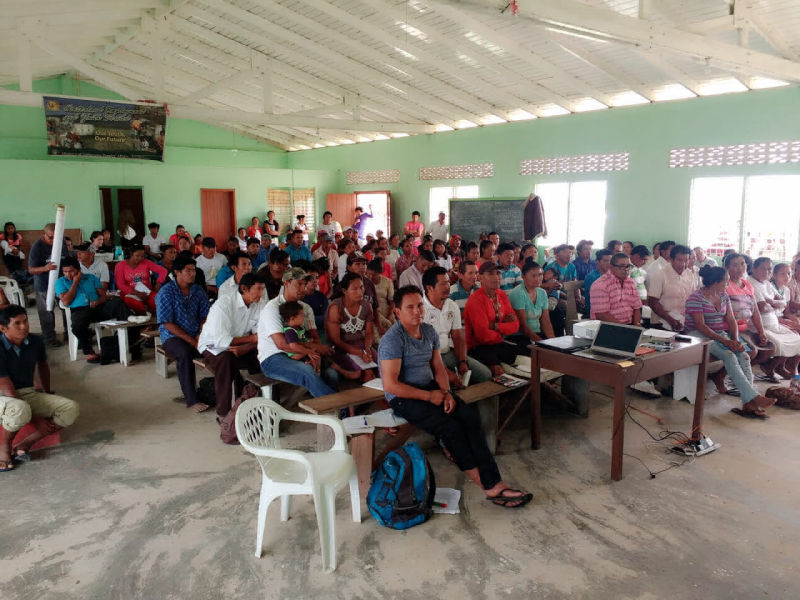
Participants at the SRDC Meeting in Awarewaunau
Toshao Nicholas Fredericks the Chairman of the National Toshaos Council and the South Rupununi District Council has been awarded the Golden Arrow Head of Acheivement for championing the rights of Indigenous Peoples in Guyana. The SRDC congratulates Toshao on receiving this Award.
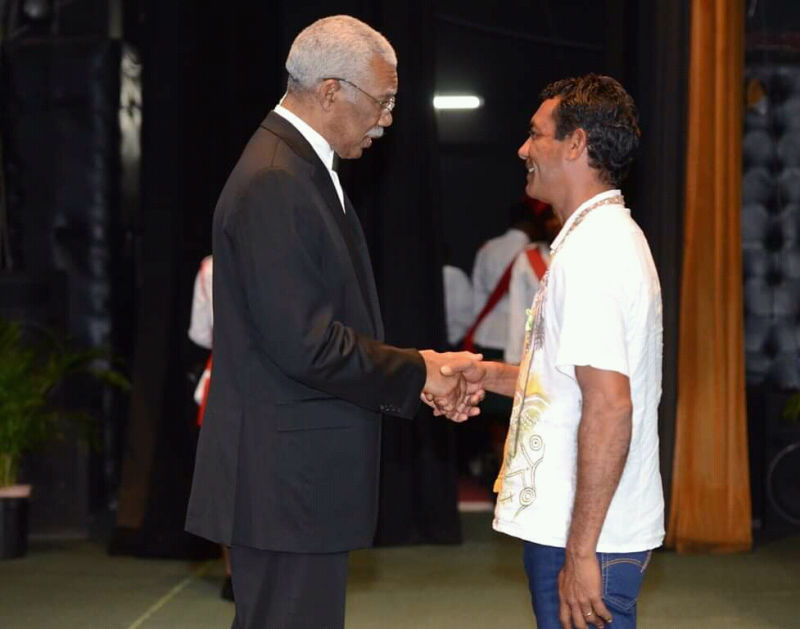
Toshao Nicholas Fredericks receives the Golden Arrow Head of Acheivement form President David Granger.
On May 23 and 24, 2019 Indigenous women leaders attended a workshop in Georgetown. This workshop was sponsored by UNESCO in association with the Women andGender Equality Commission and Forest Carbon Partnership Facility. Topics were based on ; Gender; Women's Rights and Access to Justice. The first day workshop was facilitated by Ms. Ann-Marie Williams - CARICOM Deputy Program Manager for Gender and Development who spoke on Gender and Equality; Gender and Development; and Gender and Culture.
The second day was facilitated by Ms. Vanda Radzik, REDD+ Consultant and Women and Gender Equality Specialist. Ms. Vanda Radzik spoke on REDD+ Rights, Roles and participation of Indigenous Women and the Climate Agreement and Sustainable goals (SDG) Goal 5 and Goal 13. The afternoon session was facilitated by Danuta Radzik from Help Shelter who went through the simplified version of The Sexual Offence Act; and Karen de Souza form Red Thread who spoke on The household guide to the Domestic Violence Act.
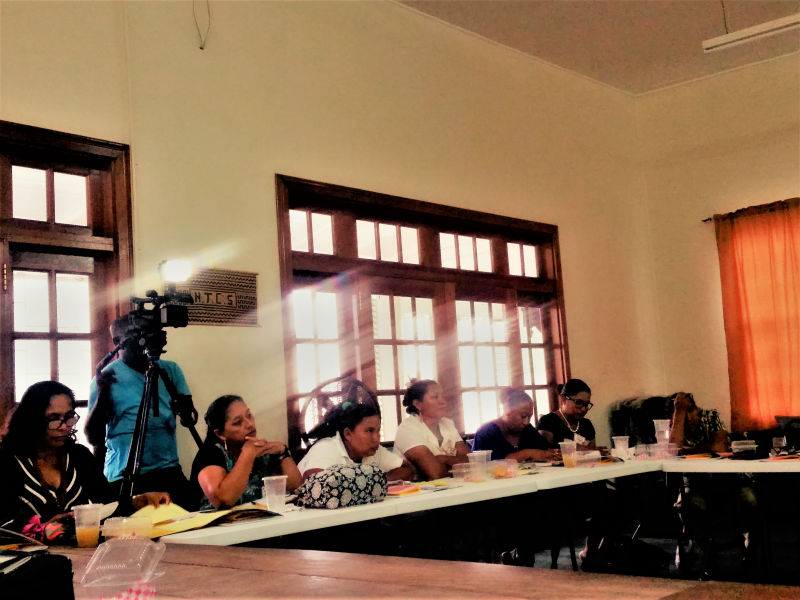
(Fourth from left) Councillor Goretti Lewis of Shulinab Village, also the Assistant Secretary/ Treasurer of the SRDC makes a request for this kind of workshops to be extended into other Indigenous communities.
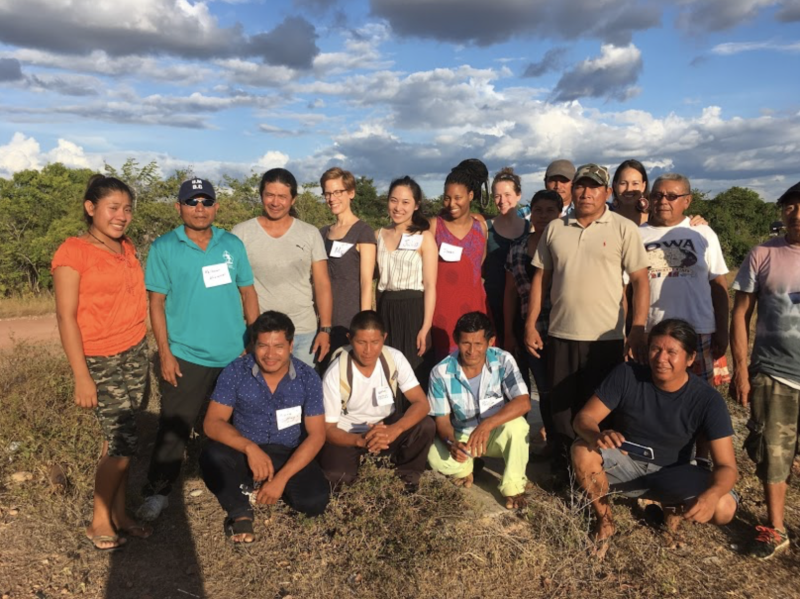
SRDC Launches Water Monitoring Pilot to Protect the Wapichanao Right to Water:
The Global Justice Clinic and Water Scientist Lend Support to Crucial New Effort.
From March 26-29, the South Rupununi District Council (SRDC) hosted a four-day water monitoring workshop which was co-facilitated by the Global Justice Clinic of NYU School of Law and Dr Beth Hoagland in Aishalton Village, Guyana. Since 2013, the SRDC has been monitoring violations of their land rights – particularly environmental degradation and illegal mining. This workshop launched the SRDC’s water monitoring pilot as an extension of the SRDC’s existing monitoring program to include monitoring the adverse impacts of mining on Wapichan territory.
The workshop served as a knowledge exchange between participants with complementary expertise. Wapichan, Kapong (Akawaio) and Pemon (Arecuna) monitors from the South Rupununi (Region 9) and the Upper Mazaruni (Region 7) shared extensive cultural and intergenerational knowledge of their environment. Monitors also shared their goals for water monitoring, their insights from years of experience participating in the SRDC’s and the Upper Mazaruni District Council’s (UMDC) existing monitoring programs, and their first-hand knowledge of the destructive impacts of mining. They applied this knowledge to prepare a detailed map of proposed water monitoring sites which will inform comprehensive water monitoring plans in their respective regions. In addition, monitors applied lessons from other countries, including Guinea, El Salvador and Haiti to generate advocacy ideas using the data collected from the water monitoring program.
Dr Hoagland, a water expert from the Colorado School of Mines, shared lessons in hydrology –the scientific study of water. This included the principles of water monitoring, water sources and the impacts of mining. In addition, Dr Hoagland demonstrated the use of field-based water monitoring equipment and the process for collecting water samples for lab testing of dissolved metals, including mercury. Professor Meg Satterthwaite, Professor of Clinical Law at New York University together with her Global Justice Clinic team of human rights lawyers and law students, shared lessons on human rights, legal empowerment and advocacy. This encompassed the legal framework behind water monitoring, including international laws that protect the rights of indigenous peoples and human rights such as the rights to water and a healthy environment, as well as Guyanese laws that regulate mining. Participants discussed the legal justifications behind a custom-made questionnaire to capture water monitoring data, and how that data can be analysed and converted into meaningful reports by the SRDC and UMDC for legal empowerment and advocacy purposes.
Having participated in the workshop, a SRDC Monitor said:
“Since I was 11 years old, I’ve been visiting Marudi Mountain and Mazao Mountain which are sacred sites for us–the Wapichan People. Over the past 31 years, I’ve been watching mining grow around Marudi and Mazoa and the resulting deforestation, excavation of water ways, disruption of the natural water flow off these mountains, and the pollution of water sources that our people depend on to live.
We know about the importance of protecting our lands and our waters because this is impressed upon us by our fore-parents. I have also learned about the environment through interactions with indigenous communities and because of my connection to nature itself. This means that for a long time, I’ve been able to look at water and know from my observations and experience whether it is contaminated. However, learning about scientific principles allows me to explain changes in water quality that I have long observed but never been able to explain in scientific terms. In addition, while I have been collecting data on the environmental harm than mining is causing for the past six years, I now have a better appreciation for the importance of collecting reliable and accurate data as evidence to protect our lands and resources. Learning about the international and Guyanese laws that protect our rights strengthens our ability to use this data as information to influence both the miners who are causing harm, and also the government authorities and decision makers who have an obligation to regulate mining and protect our environment, but are presently falling short of their responsibilities.
In the past, the water around our community was safe to use and drink but this was before miners contaminated our water sources. For years, the destruction that mining causes to Wapichan territory has been dismissed by miners and government authorities. This has to stop and I will use what I have learned to support the SRDC protect and defend our lands and waters from mining and other destructive activities.
Applying the knowledge that I deepened during the water monitoring workshop, I have been reflecting upon why my fore-parents may have defined Marudi, Mazao and the entire Karawaimintau mountain range as sacred sites. I find myself wondering whether their cultural significance is centred around their importance as watersheds, because this is what allows the mountains to sustain life in the broadest sense - not only the life of our peoples, but also the life of plants, trees, wildlife and the spiritual beings”.
A key takeaway from the water monitoring workshop was a lesson imparted by the Wapichan, Kapong (Akawaio) and Pemon (Arecuna) peoples: that each of us are only one small part of an entire ecosystem, and all our actions have consequences that will impact future generations.
https://www.stabroeknews.com/2019/news/guyana/01/27/all-the-creeks-are-polluted-people-have-a-lot-more-mercury-in-their-system/?fbclid=IwAR1M6kXAhFirIwi7Nu6TYL5w22cjkUkUqWsl0W6dAcMzj86ScEjGT8zSU5I
Subtitle, Date, or Author
Insert your news summary here
1/29/2019 Marudi a ‘hell hole’ as small miners return - South Rupununi Council chairman says
Over the past two weeks, miners from Georgetown, Lethem and Brazil have returned to the Marudi Mountain area in the South Rupununi and it is a “a hell hole right now,” according to South Rupununi District Council (SRDC) chairman Nicholas Fredericks.
Fredericks told the Sunday Stabroek that he does not know whether or not they have permission to mine. “Socially and environmentally, it is impacting on the life of the surrounding communities. We are now seeing the impact. All the creeks are polluted. People have a lot more mercury in their system. The miners are back and everything is chaotic,” he said in an interview on Thursday.
Fredericks, who is also the Chairman of the National Toshaos Council (NTC), explained that just over a year ago, with assistance from the World Wildlife Fund for Nature, residents from four communities Shulinab, Karaudarnau, Aishalton and Para Bara—underwent mercury tests.
The results showed that residents from Para Bara village had the highest level of mercury in their systems. “They are contaminated from the mines in Wakadanawa which ows into Kuyuwini River and also from waterways from Marudi Mountain, which ows into Kuyuwini. The water in Kuyuwini is red right now. They have no savannahs around them, so they depend heavily on the creeks for sh. Morning, noon and night, they eat sh. That is why they are so high in mercury intake,” he said. The SRDC is having discussions on mercury contamination in the villages, he said, and is looking at how this situation is addressed, and how it could be fed into the Minamata Convention on Mercury, to which Guyana is a signatory. In Region Nine (Upper Essequibo/Upper Takutu), he said, “There are very few creeks and rivers that are not contaminated. Only one waterway in Region Nine, that is, the Rupununi River, is not contaminated by mercury and that is because its source is not in any mining area. “Takutu River on the border with Brazil, the mighty Essequibo, Rewa and Potaro rivers are contaminated by mining. We do environmental monitoring. That is why we have all this data.”
The Marudi Mountains, known Marutu Taawa to the Wapichan people and which is a sacred site to them, is the source of several of the country’s main waterways, he noted. In recent months, pollution in the waters had eased up following an agreement signed between miners and the SRDC until certain conditions were met, Fredericks said. The agreement was reached during mediation facilitated by retired Major General Joe Singh. “During that time, through a joint e ort between the Guyana Geology and Mines Commission (GGMC) and the security forces, we got the miners to move out of the area. The pollution had eased a lot,” he said.
However, two Brazilian miners did not move and they have caused a lot of destruction, he said. “Now they are heading even further south to another sacred mountain. They are out of control,” Fredericks declared. Fredericks said it does not appear that the GGMC is making an e ort to deal with the situation.
“We cannot even verify if they are mining in a claim or they are mining out of a claim. We do not know and GGMC is reluctant to provide that information to us. I would go so far as to say I don’t think that they themselves know exactly if this operation is on a claim or not and whose claim it is. People are just jumping all over the place and doing as they please. It is terrible. Brazilians, coastlanders and Lethem business people. No indigenous person owns a dredge in there,” the NTC chairman said. Fredericks said although it is illegal to use crushers and the miners are still using them. “We cannot do anything about it without the authorities and the law enforcement agencies. They have threatened my life more than once. They sent me messages that they were going to come and kill me. It shouldn’t be hard for them to do that. It’s terrible. I know where the threats are coming from,” he said. Asked if he has reported the threats to the police, he said, “I have never reported. It would make no di erence or it would make things worse.” On the issue of Romanex Guyana Exploration Limited’s - a subsidiary of the Canadian company Guyana Goldstrike - application to do large scale mining at Marudi, he said, the SRDC, representing 14 indigenous communities, has objected to the EPA granting them approval based on their draft Environmental Social Impact Assessment (ESIA). At present, he said, the SRDC wants the EPA to revoke the “flawed draft ESIA,” and to conduct another with the full participation of the indigenous peoples who are a affected by the mining, through the free, prior and informed consent process. Though the SRDC has not received a written response to its concerns expressed in relation to the ESIA, Fredericks said the SRDC met with the head of the EPA and was heartened to note that their concerns were noted. “We are looking to protect the environment. From what we have seen, the company is not clear on their whole method of mining. Based on the reports we are seeing from them, their information is not adding up,” he said. more...
CERD Recommendations to Government of Guyana re: Activities on Marudi Mountain
11 January 2019
The Wapichan People of the South Rupununi welcome the recent Communication sent to the Government of Guyana by the United Nations Committee on the Elimination of Racial Discrimination concerning the mining on Marutu Taawa (Marudi Mountain). The UN Committee’s Communication is timely and crucial, as we continue to fight the contamination, pollution, and destruction of our sacred mountain, which is also an important watershed at the source of Guyana’s main waterways. The issue of mining at Marutu Taawa is a matter of grave concern, as it affects our Constitutional rights to health and a healthy environment, as well as to the protection, preservation, and promulgation of our cultural heritage and way of life.
The Communication stresses that the UN Committee is concerned that we, the affected people, have not been involved in an effective and meaningful manner in the decision-making surrounding mining at Marutu Taawa. The latest example of our marginalization has been the failure to include our participation and to address our concerns in the draft Environmental and Social Impact Assessment of the Romanex mining project.
This is the second time in 2018 that the UN Committee has written to the Government of Guyana, urging it to protect and respect our rights under the International Convention on the Elimination of Racial Discrimination. In the first Communication, the UN Committee had recommended the Government ensure that environmental and social impact assessments of the proposed mining project on Marutu Taawa were conducted with our participation. This did not happen, and we welcome the Committee’s follow-up on this matter.
We urge the Government to respect its treaty obligations and to follow the recommendations of the UN Committee and to:
1. Revoke the flawed draft Environmental and Social Impact Assessment;
2. Conduct an environmental and social impact assessment with our full participation, as the indigenous peoples affected by the mining project on Marutu Taawa; and
3. Suspend the mining project on Marutu Taawa until we have given our free, prior, and informed consent to the project following full and adequate consultation.
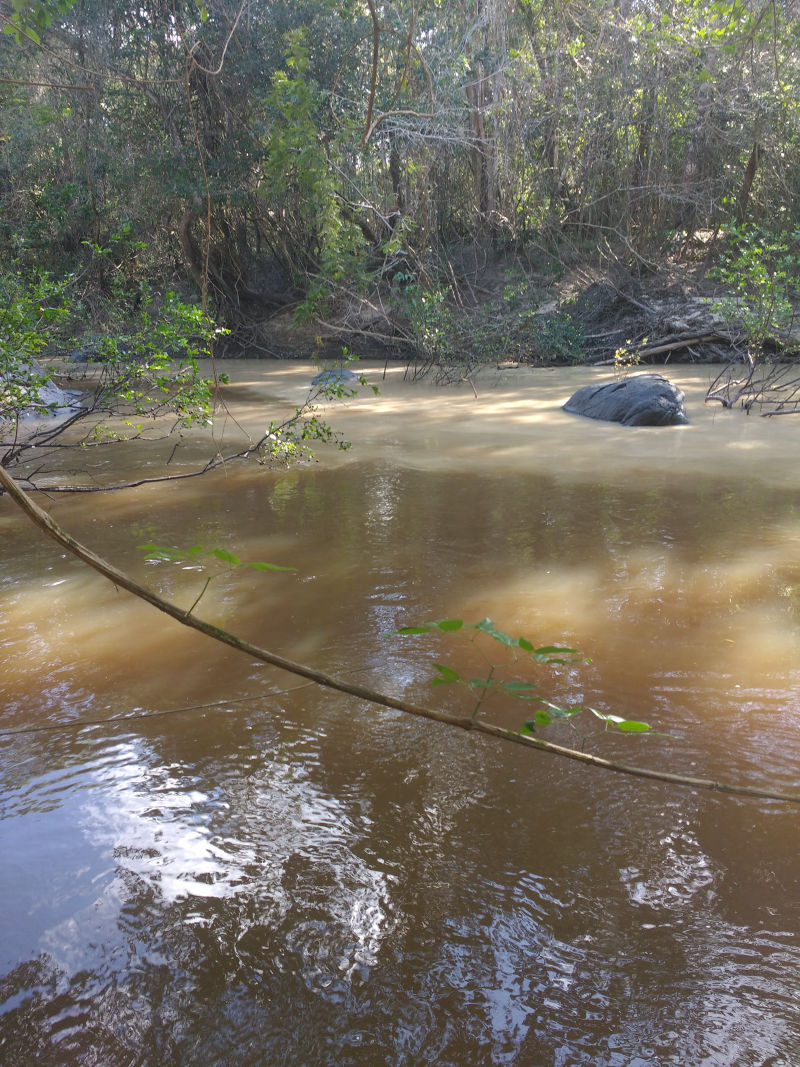
One of the rivers polluted by mining in Wapichan Wiizi